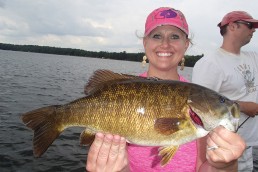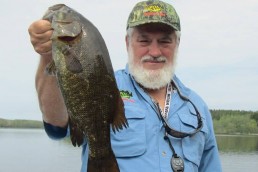Five Philosophies for Smallmouths
SHARE THIS POST
Analyzing fundamental fishing values to help catch more bass
The information age makes it easy to pick up fishing techniques. Andrew Ragas shares five fishing philosophies that will inform your fishing methods and put more smallmouth bass in your livewell.
#1. Camp for bites
Some of my partners give me grief for fishing methodically and too slowly. After several years of patterning big bass and understanding their locations, feeding times and behavior, I sometimes camp on spots. I focus on precise locations for long periods of time because I seek big bites that can come from these spots.
Big bass are intelligent, and some of the smallmouths I catch from Wisconsin’s inland lakes have been around for 20 years or more. They’ve seen lots of lures, and might have been caught and released dozens of times. Catching them requires savvy skill. Identifying and locating big fish spots doesn’t happen overnight, or by quickly studying a lake map.
From nesting, to feeding and wintering, big bass historically use the same specific locations of a lake every year. Learning a fish’s behavior can require several years of patterning a lake and its bass. The same patterns usually re-establish every season.
Big fish spots can be considered as high-percentage locations that big bass us annually. They might stay on them the whole season. These prime locations include humps, spawning flats, feeding areas, and structure such as rocks and fish cribs. These are the types of locations I fish for several minutes or even hours at a time.
I camp during peak feeding and lunar periods, as well as when bass stage in spring and school up in fall. I also camp on specific locations that yield big bass annually.
Camping–in terms of fishing techniques–pays off
For example, a year ago I hosted a good friend for a trophy hunt on a favorite low-density trophy fishery. Our strategy for the afternoon was to seek one bite. Most days, that one bite is from a smallmouth of 5 pounds or more. We planned to target just a few spots that consistently yield big fish. One spot was a mid-lake gravel hump topping off at 3 feet and I positioned my boat on its drop-off. On our first slow circle of casting around the 30-yard-wide hump, I hooked and lost about a 5-pounder on a football jig. I decided to camp us on that spot for 30 more minutes, hoping that fish would strike again.
Many anglers might choose to return to that spot later in the day or during a peak phase or weather change. That’s a wise strategy. But if fixated on one single bite and knowing a trophy is nearby, we camped. Three more passes around the hump paid off. That same fish struck a tube jig and we caught it. I’ve learned a big bite can return. It all depends on how willing you are to invest the extra time.
My camping strategy doesn’t pay off every time. Sometimes it proves futile, and I’ve died by it. If you want to catch several fish, don’t camp during major feeding windows when several spots on the lake could have active fish. Don’t camp if you’re short on time, either. Speed fishing is better. Lastly, you cannot break down a new fishery by camping on spots and fishing slow.
While camping on spots annoys some of my impatient partners, the positives outweigh the negatives. This philosophy has led to lots of personal success over the years.
#2. Don’t leave fish to find fish
It’s an old saw, but leaving fish to find fish is almost never a good idea.
As a part time fishing guide, I’m often faced with this dilemma: Should we leave active fish to check out similar locations?
If the fishing is good keep the momentum going by doing nothing. Don’t leave the area or adjust tactics. Bass move in and out of locations, so if a bite slows, I anticipate it eventually will resume. If the spot isn’t over-pressured, or exhausted, don’t leave the fish that use it.
Leaving fish to find more fish can be a big mistake. It can also ruin or slow down what originally started out as a successful outing. If you leave, you might not enjoy the same success elsewhere.
Clients pay me to put them on fish and deliver their money’s worth as well as provide an educational and productive fishing experience. I cater fishing trips according to my guest’s preferences. Some anglers just want to catch fish, while others want to learn a new lake and some good spots. I never want to waste a customer’s time or money, so productivity is most important.
Leaving fish to find fish is a huge risk. The only good thing that comes from it is covering water, trying several spots, and learning an entire lake.
#3. Establish patterns by eliminating tackle
Employing this philosophy helps me establish patterns more quickly.
Are you enjoying this post?
You can be among the first to get the latest info on where to go, what to use and how to use it!
Not every bass angler needs 10 rods on their casting deck like I sometimes do, but an array rigged with different lures helps establish patterns quickly as you can easily alter presentations.
We can only cast with one rod at a time though. When bass only show interest in a general lure category, I experiment with other baits within that category and vary the presentation that worked. For example if fish show interest in a suspending jerkbait, I might tie on different variations of that lure category on 4 different rods to truly capitalize on a jerkbait bite. I might try different models, lengths, sizes, weights, diving depths, and colors. Then, I put all other unnecessary gear away because I’ve found what the fish want.
Many bass anglers tend to overload their front decks and might prioritize the wrong things in their fishing approach. They’re better off to focus on fundamentals, tactics and strategies. By eliminating tackle as I establish a pattern, I reduce clutter and confusion, and enjoy more success. I am more practical and efficient with just 4 or 5 rods on deck with baits that are working.
#4. Running and gunning fishing methods are overrated
Many of the best smallouth fisheries in the north are clear oligotrophic and mesotrophic lakes. Fish in them tend to spook easily. Their lateral lines and eyesight are more sensitive to disturbances. On these clear waters, smallmouths can see far, and can feel everything atop the surface above them. So running and gunning isn’t the wisest strategy.
The noise from outboard and shadow of a boat can scare fish down deep where they are tougher to catch.
I focus on stealth, and often idle or drift into spots as quietly as possible. This keeps wary and curious smallmouths catchable, and mostly unaware of invaders overhead.
Many bass anglers who practice run and gun tactics don’t efficiently fish spots how they should. It’s often best to dissect a spot to learn its potential and learn if fish are there. Many anglers don’t know how to fully use their electronics to map, chart, and mark fish. Adept anglers first slowly idle around and scan for fish with side imaging, then drop waypoints and icons on fish and pieces of structure. Then they cast to those icons and waypoints.
For every spot, have a strategy. Run a track between waypoints and along contours. Always map and scan over a spot before fishing it. This leads to angling efficiency. Let others learn the futility of the thundering scare tactics of running and gunning.
#5. Don’t be a bank beater
“I’m a shallow-water guy. If I can’t catch them beating the bank, I’m probably not going to catch them. I just can’t make myself to fish offshore.”
That limited viewpoint means the fish I focus on are the least pressured and I have them mostly to myself.
Fishing shorelines, docks, and near-shore habitats can be a mistake. Don’t be a bank beater.
Most of the fishing pressure bass receive is near shorelines. You will learn that better smallmouth fishing is often towards the center of the lake.
Smallmouth bass relate to deeper structure year-round, roaming shorelines only when food is shallow and water temperature is ideal. Only small smallmouths live in the shallows. Larger smallmouths on most lakes live deeper.
Bank-fixated anglers fail to understand that most shorelines are dead, unproductive water.
The biggest bass usually use deep structure and cover. They also roam open water to follow food. Sadly, most shoreline anglers just aren’t comfortable exploring beyond the shallow banks.
While philosophers such as Pythagoras, Aristotle and Socrates would pose more practical questions pertaining to life, bass anglers would be wise to establish their own philosophies to form a personal handbook for success. Consider these fundamental fishing values to help make you a more successful bass angler for seasons to come.
Author notes:
Andrew Ragas splits time between the Chicago area and Wisconsin’s Northwoods. Based in Minocqua, Wisconsin, he specializes in bass fishing and offers guided trips. Contact him through his website, northwoodsbass.com.
MWO
SHARE THIS POST
Did you enjoy this post?
You can be among the first to get the latest info on where to go, what to use and how to use it!
Andrew Ragas
Andrew Ragas splits time between Chicago and Wisconsin’s Northwoods. Based in Minocqua, Wis., he specializes in trophy bass fishing and offers guided trips from May through October. While big bass are his passion, he dabbles in multispecies, as well. He may be visited online at northwoodsbass.com



